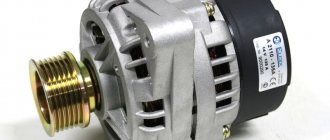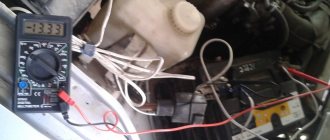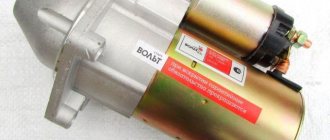A generator in any car, even a diesel one, is a real general manager of the engine. Without it, the car won't move. It can be a shame when the engine works well, but the electrical equipment begins to malfunction. If we talk about the six, then most likely it contains the G 221 generator, which was also equipped with the Fiat 124.
If you compare the electrical circuits of the VAZ 2101 and VAZ 2106 cars, it becomes obvious that they are almost the same. The six only has a few additional electrical devices. However, the generator there is the same. That is the problem. The fact is that initially the G 221 model was not intended to serve such a number of energy consumers. As a result, the relay-regulator receives insufficient current, the battery is undercharged and slowly dies.
The problem gets worse when the car owner installs additional devices, such as:
- Fog lights;
- Good audio system;
- Preheating before starting;
- second stove, refrigerator, TV, etc.
In general, any step that increases energy use can make the battery prone to drain even while you're on the road. If modifications are still necessary, then you will have to install a more stable and powerful generator G 222.
Generator VAZ 2106: purpose and functions
A car generator is a small electrical device whose main task is to convert mechanical energy into electrical current. In the design of any car, a generator is needed to charge the battery and feed all electronic devices while the engine is running.
Thus, the battery receives the necessary energy for engine operation from the generator, so we can say that the generator is an indispensable attribute in the design of any car.
The generator's task is to ensure uninterrupted operation of all electrical systems of the machine and the battery.
How exactly does the generator work on a VAZ 2106? All processes of energy conversion from mechanical to electrical are carried out according to a strict scheme:
- The driver turns the key in the ignition.
- Immediately, the current from the battery through the brushes and other contacts enters the excitation winding.
- It is in the winding that the magnetic field appears.
- The crankshaft begins to rotate, from which the generator rotor is also driven (the generator is connected to the crankshaft by a belt drive).
- As soon as the generator rotor reaches a certain rotation speed, the generator enters the self-excitation stage, that is, in the future, all electronic systems are powered only from it.
- The generator performance indicator on the VAZ 2106 is displayed in the form of a control lamp on the dashboard, so the driver can always see whether the device has enough charge for full operation of the car.
Read about the design of the VAZ 2106 instrument panel: https://bumper.guru/klassicheskie-modeli-vaz/elektrooborudovanie/panel-priborov/panel-priborov-vaz-2106.html
Standard device for the "six"
Design of the G-221 generator
Before talking about the design features of the VAZ 2106 generator, it should be clarified that it has unique clamps for mounting on the engine. On the body of the device there are special “ears” into which studs are inserted and tightened with nuts. And so that the “ears” do not wear out during operation, their internal parts are equipped with a high-strength rubber gasket.
The generator itself consists of several elements, each of which we will now consider separately. All these devices are built into a light-alloy cast housing. To prevent the device from overheating during long-term operation, the case has many small holes for ventilation.
The device is securely fixed in the engine and connects to various car systems
Winding
Due to the fact that the generator has three phases, windings are installed in it immediately. The purpose of the windings is to generate a magnetic field. Of course, only special copper wire is used for their manufacture. However, to protect against overheating, the winding wires are covered with two layers of heat-insulating material or varnish.
Thick copper wire rarely breaks or burns out, so this part of the generator is considered the most durable
Relay regulator
This is the name of the electronic circuit that controls the voltage at the output of the generator. The relay is necessary to ensure that a strictly limited amount of voltage reaches the battery and other devices. That is, the main function of the relay regulator is to control overloads and maintain an optimal voltage in the network of about 13.5 V.
A small plate with built-in circuitry to monitor the output voltage
Rotor
The rotor is the main electric magnet of the generator. It has only one winding and is located on the crankshaft. It is the rotor that begins to rotate after the crankshaft starts and gives movement to all other parts of the device.
The rotor is the main rotating element of the generator
Generator brushes
The generator brushes are located in brush holders and are needed to generate current. In the entire structure, it is the brushes that wear out the fastest, since the main work of generating energy falls on them.
The outer side of the brushes can quickly wear out, which is why there are interruptions in the operation of the VAZ 2106 generator
Diode bridge
A diode bridge is most often called a rectifier. It consists of 6 diodes that are placed on a printed circuit board. The main job of a rectifier is to convert alternating current into direct current to maintain stable operation of all electronic devices in the car.
Due to its specific shape, drivers often call the diode bridge a “horseshoe”
Pulley
The pulley is the driving element of the generator. The belt is tensioned simultaneously on two pulleys: the crankshaft and the generator, so the operation of the two mechanisms is continuously interconnected.
One of the generator elements
What is needed for maintenance
Very often a malfunction occurs such as excessive wear of bearings. As a rule, the one located in the front cover fails. You can even detect a breakdown by hearing. A loud whistle indicates its failure. The reason that it is in the front cover that the bearing fails is that it is subjected to a very large load. After all, it is on this side that the belt is located.
The 2106 generator's brushes, made of graphite, are in constant contact with the rotor. Their strength is quite high, but despite this, the effect of friction makes itself felt. Therefore, they need to be replaced with new ones from time to time. If this is not done, the field winding will not work.
No power is supplied to it, and the magnetic field that is necessary to generate electricity is not created. It happens that the excitation winding, or one of the stator windings, begins to “short” to ground. To verify this, it is necessary to completely disassemble the VAZ 2106 generator, and then use a multimeter to test all windings without exception.
You should have at least an idea of how to check the windings for breakdown. Please note that there must be a certain resistance in the stator, depending on the generator model. If there is no resistance, there is a short circuit to the device body.
Choose your own way out of this situation. You can either rewind the stator winding, replace it completely, or install a new power source. The price of a new one, of course, is rather high - about 3000-3500 rubles. You can buy it at a dealership for three times the price, but will it work properly?
Technical characteristics of the VAZ 2106 generator
The “six” comes from the factory with a G-221 generator, which is classified as a synchronous alternating current device. The device is fixed to the engine on the right side, but it can only be adjusted or changed from under the body, since it is difficult to get to the generator from above due to the presence of many hoses, devices and instruments.
The nominal voltage of the G-221 corresponds to the voltage of a typical VAZ battery - 12 volts. The generator rotor rotates to the right (when viewed from the drive side), since this feature is due to the position of the generator relative to the crankshaft.
The maximum current that the VAZ 2106 generator is capable of delivering at a rotor speed of 5000 rpm is 42 amperes. Power indicator - at least 300 watts.
The device weighs 4.3 kilograms and has the following dimensions:
- width - 15 cm;
- height - 15 cm;
- length - 22 cm.
Standard device for equipping all VAZ 2106
What generators can be installed on the “six”
Structurally, the VAZ 2106 is ready to install a generator not provided by the manufacturer. The question arises: why change the “native” G-221 at all? In fact, for its time, this generator was the optimal device, since Soviet Zhiguli cars used a small number of electrical appliances.
However, over time, the VAZ 2106 began to be equipped with more modern devices, each of which requires “its share” of energy . In addition, drivers connect navigators, cameras, pumps, powerful audio systems and other devices to the battery, which makes it difficult for the generator to generate the required amount of current.
Therefore, car owners began to look for equipment options that, on the one hand, would allow all the equipment in the car to operate in normal mode and, on the other hand, would have an optimal effect on the battery life.
Today the following types of generators can be installed on the VAZ 2106:
- G-222 is a generator from the Lada Niva, which is designed for higher loads and produces 50 amperes of current. The G-222 design already has its own regulator relay, so when installing it on a VAZ 2106, the relay will need to be removed.
- G-2108 can be installed on both “six” and “seven” and “eight”. The device in normal operation produces 55 amperes of current, which even by modern standards is quite enough for the functioning of all electronic devices in the car. The shape and fasteners of the G-2108 are identical to the standard G-221, so there will be no problems with replacement.
- G-2107–3701010 produces 80 amperes and is intended for lovers of high-quality acoustics and additional electronic devices in the car. The only caveat: the generator for the VAZ 2106 will have to be slightly modified, since the regulator relay is not suitable for this model.
Photo gallery: generators that can be installed on the VAZ 2106
The device from Niva has good traction
The generator from the G8 is considered a more modern unit
The most productive device in VAZ equipment
Find out about the repair of VAZ 2106 units: https://bumper.guru/klassicheskie-modeli-vaz/poleznoe/remont-vaz-2106.html
Thus, the driver of the “six” can decide for himself which generator can be installed on the car. The choice ultimately depends only on the power consumption of the car.
Dismantling and removal
How to dismantle the VAZ generator and how to dismantle the device? Which generator is better to install on the VAZ-A 2106?
To restore the VAZ 2106 generator, follow these steps:
- First, unplug the plug from pin 67 to the node.
- Then disconnect the plug from the so-called terminal. neutral cable.
- Then move the insulating cover slightly, then the 10 flat wrench to unscrew the cable nut, especially for the thirtieth saw. The wiring harness may be disconnected.
- Now you can take off the strap. If you just need to replace it, buy a good bar - check its condition if there is no damage to the tape. The VAZ 2106 alternator belt size must be compatible with the nominal one, it is indicated in the service manual.
- Using a 17mm flat wrench, unscrew the two nuts that protect the adjusting rod to be removed.
- Then unscrew the lower nut securing mechanism, remove the screw, as well as the bushing. The assembly itself will be attached to the bracket.
- Then you can remove the group. In case, we recommend that you additionally read the article by our VAZ-2106 generator repair specialist.
Here is a list of actions that should absolutely not be performed during verification:
- The functional test should not be carried out during a short circuit or in other words a “spark”;
- connect terminals of different configurations to each other, and also connect terminal 30 or B + to ground;
- diagnostics and operation of the generator cannot begin without connected consumers. This is especially important to observe when the battery is disconnected;
Generator connection diagram
Being an electronic device, the generator needs to be connected correctly. Therefore, the connection diagram should not cause double interpretation.
A schematic diagram of exactly how the G-221 is connected to a VAZ 2106 can be viewed here.
All components of the circuit are as clear as possible, so no separate explanation is required
Many car owners wonder when replacing a generator where which wire should be connected. The fact is that the device has several connectors and wires, and when replacing, you can easily forget which wire goes where:
- orange is not useful for connection, it can be left as is, or connected to gray directly to autostart the car;
- a gray thick wire goes to the brushes from the regulator relay;
- a gray thin wire connects to the relay;
- yellow - coordinator of the control light on the control panel.
Thus, when working independently with the G-221, it is better to sign the meanings of the wires so as not to connect them by mistake later.
The most difficult thing about working with a generator is connecting it correctly
Regulator replacement
- The regulator is located on the left mudguard. Unscrew the fastening nuts and remove the device.
- Disconnecting the wiring
- We install the new regulator, connect the wiring to it in the same way as they were installed on the previous device. Tighten the fastening nuts.
Generator malfunctions on VAZ 2106
Like any other mechanism in a vehicle, the “six” generator can work incorrectly, break down and fail. However, cases of unexpected breakdowns are extremely rare, since the driver can always track the occurrence of a “disease” by noticing its first signs.
The charging indicator light came on
There is a lamp on the instrument panel that indicates the functionality of the generator. It can blink or stay on continuously. In any case, the activation of this indicator is considered the first signal of a malfunction in the generator.
| Cause of malfunction | Remedies |
| Slipping of the generator drive belt Break in the connection between plug “85” of the charge warning lamp relay and the generator The battery charge warning lamp relay is misregulated or damaged Break in the power supply circuit of the excitation winding The voltage regulator is misaligned or damaged Wear or freezing of the generator brushes; oxidation of slip rings Open circuit or short circuit to ground of the excitation winding of the generator Short circuit of one or more positive diodes of the generator Open circuit in one or more diodes of the generator Open circuit in the connection between plugs “86” and “87” of the charge control lamp relay Open circuit or interturn short circuit in stator winding | Adjust the tension of the generator belt Check and restore the connection Check the relay, adjust or replace it Restore the connection Clean the contacts, adjust or replace the voltage regulator Replace the brush holder with brushes; wipe the rings with a rag soaked in gasoline Attach the winding leads to the slip rings or replace the rotor Replace the radiator with positive diodes Replace the generator rectifier unit Restore the connection Replace the generator stator |
Battery won't charge
The generator can work, but the battery is not charging. This is the main problem of the G-221.
| Cause of malfunction | Remedies |
| Weak tension of the generator belt: slipping at high speeds and when the generator is running under load. The fastening of the wire lugs on the generator and battery is loose; battery terminals are oxidized; Wires are damaged Battery is faulty Voltage regulator is misaligned or damaged | Adjust the tension of the generator belt Clean the battery terminals from oxides, tighten the clamps, replace damaged wires Replace the battery Clean the contacts, adjust or replace the regulator |
Find out how to start a car with a dead battery: https://bumper.guru/klassicheskie-modeli-vaz/poleznoe/kak-zavesti-mashinu-esli-sel-akkumulyator.html
The battery is boiling over
If the generator connection is poor, there may be a problem with the battery.
| Cause of malfunction | Remedies |
| Poor contact between ground and voltage regulator housing Voltage regulator is misaligned or damaged Battery is faulty | Restore contact Adjust or replace voltage regulator Replace battery |
The generator is very noisy
The device itself should make sounds during operation, since the rotor is constantly rotating. However, if the operation sound is extremely loud, you need to stop and find out what's wrong.
| Cause of malfunction | Remedies |
| The generator pulley nut is loose The generator bearings are damaged Inter-turn short circuit of the stator winding (generator whine) Brush creaking | Tighten the nut Replace the bearings Replace the stator Wipe the brushes and slip rings with a cotton cloth soaked in gasoline |
Video “Do-it-yourself mechanism repair”
For more information on how to repair a “six” generator device at home, see the video below (the author of the video is Nikolai Purtov).
The generator is the source that is responsible for recharging the battery while driving. If the generator does not work properly or is unstable, the battery discharges too quickly and requires constant recharging from the electrical network. Since you can check the generator at home, if you have a problem with the battery quickly discharging, it is not necessary to go to a service station for diagnostics.
If a generator is suspected of malfunctioning, the car owner first tries to identify the breakdown himself. There are several verification methods that involve measuring both a removed and an undismantled device. The verification in both cases will be reliable. In addition to knowing how to check the generator, you need to find out the reasons why it may fail. Although the generator is a fairly reliable device, incorrect or careless operation of the car can cause it to fail prematurely.
How to check the generator
Checking the functionality of the device will give the driver confidence that it is working properly and there is no cause for concern.
It is prohibited to check the generator on a VAZ 2106 when it is disconnected from the battery while the engine is running, as a voltage surge is possible. In turn, instability of operation can damage the diode bridge.
Checking the functionality of the generator can be done in various ways. The most common are:
- checking with a multimeter;
- at the stand;
- when using an oscilloscope.
Self-check with a multimeter
This technique is the simplest and does not require special devices or extensive knowledge of how the car works. However, it is necessary to purchase a digital or indicator multimeter, and also enlist the help of a friend, since the test involves the work of two people at once:
- Set the multimeter to DC measurement mode.
- Connect the device to each battery terminal in turn. The voltage should be between 11.9 and 12.6 V.
- The assistant should start the engine and leave it idling.
- At this time, the measurer must carefully monitor the multimeter readings. If the voltage in the network drops sharply, it means that the generator is not working fully, or its resource is not enough to charge.
- If the indicator is more than 14.5 V, the driver needs to know that such operation of the device will in the near future lead to the boiling of the battery.
The fastest way to find out what condition the generator is in
Testing at the stand
The check is carried out on a computer stand by service station specialists. In this case, the generator will not need to be removed from the car, since the computer is connected to the device through special probes.
The stand allows you to simultaneously check a working generator in all respects with high accuracy. Current performance indicators will be displayed on the computer screen, so the car owner can determine the “weak” points of his generator in real time.
The computer immediately determines all the operating parameters of the device
Checking with an oscilloscope
An oscilloscope is a device that reads basic voltage readings and converts them into waveforms. The device screen displays curved lines, from which a specialist can immediately identify defects in the operation of the generator.
The device can be used to check the functionality of any device
Check Features
When checking the generator of a VAZ 2110, 2107 and others for serviceability, the following conditions must be met:
- An accurate multimeter should be used for diagnosis.
- The normal voltage is 12 V.
- If it is necessary to replace the wiring, you must use wires with the same cross-section as the original.
- Before checking, you should check that all fasteners are connected correctly and the belt tension is correct. If necessary, the connections should be adjusted to normal, the belt should be loosened or tightened.
During the verification process it is prohibited:
- short circuit the wires;
- connect terminals that differ in purpose and parameters, connect terminal 30 or B+ to ground;
- diagnose a generator without connected consumers.
How to remove, disassemble and repair a generator on a VAZ 2106
The G-221 generator on the “six” cannot be called a simple device. Therefore, in order to carry out certain repair work, careful preparation will be required, since you will have to first remove the device from the car and then disassemble it.
Removing the generator from the car
To quickly and safely remove the G-221 from the machine, it is recommended to prepare the tools in advance:
- open-end wrench 10;
- open-end wrench 17;
- open-end wrench 19;
- mounting blade.
Of course, it is easiest to work with a cooled engine, so you need to let the car sit for a while after the trip.
The generator is held on by two long pins
The process of removing the generator is carried out according to this scheme:
- Loosen the lower generator fixing nut. Then loosen the nut on the other stud.
- Remove the nuts along with washers.
- Move the generator slightly forward (relative to the engine).
- This movement will allow you to easily remove the belt (first from the generator pulley, then from the crankshaft pulley).
- Remove the wires from the terminal.
- Disconnect the wire from the winding plug.
- Remove the wire from the brush holder.
- It is immediately recommended to label the wires by color and connection location, since problems may arise when reinstalling the generator.
- Next, unscrew the nut from the stud of the lower mounting of the generator.
- Remove the generator from the studs.
Video: dismantling instructions
Disassembling the generator
After the device has been dismantled, it must be disassembled for subsequent repairs. To do this, let's change the set of tools:
- open-end wrench 19;
- socket wrench 19;
- ratchet (you can add an extension);
- head at 8;
- head at 10;
- small hammer.
It is recommended to put small parts in separate containers so as not to lose them.
Next, if necessary, you can lightly clean the device body from dirt and begin disassembling:
- Unscrew the four fastening nuts on the back cover.
- Using a 19mm wrench, unscrew the pulley mounting nut (to do this, you will need to carefully fix the generator in a vice).
- After this, you can separate the device into two parts. If the halves are jammed, you can lightly tap them with a hammer. As a result, two equivalent parts should remain in your hands: a rotor with a pulley and a stator with a winding.
- Remove the pulley from the rotor.
- Pull the key and key out of the housing cavity.
- Next, pull the rotor itself along with the bearing towards you.
- The other part of the generator (stator with winding) is also disassembled into parts; you just need to pull the winding towards you.
Video: disassembly instructions
After disassembly, it is necessary to clarify which element of the generator needs to be replaced. Further repairs are not particularly difficult, since all components of the generator are interchangeable and can be easily removed/put on.
Generator belt
Of course, the G-221 will not work without a drive belt. The belt for the VAZ 2106 generator is 10 mm wide and 940 mm long. It is wedge-shaped and toothed in appearance, which allows it to easily cling to the teeth of pulleys.
The belt resource is designed for 80 thousand kilometers.
The belt is made of high-strength rubber and is designed for a long period of operation.
How to tighten a belt
Tensioning the alternator belt after installing it is considered the final stage of work. For fast and high-quality work, you will need to comply with the factory tension regulations:
- Loosen the self-locking nut (on the top of the generator).
- Loosen the lower generator fixing nut.
- The body of the device should move slightly.
- Insert a pry bar between the generator housing and the pump housing.
- Move the pry bar to tighten the belt.
- Without releasing the mount, tighten the self-locking nut.
- Then check the belt tension.
- Tighten the bottom nut.











